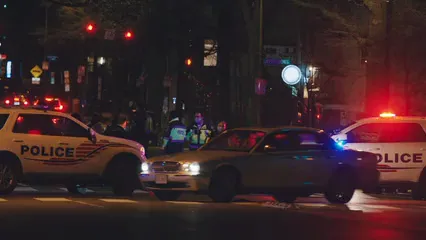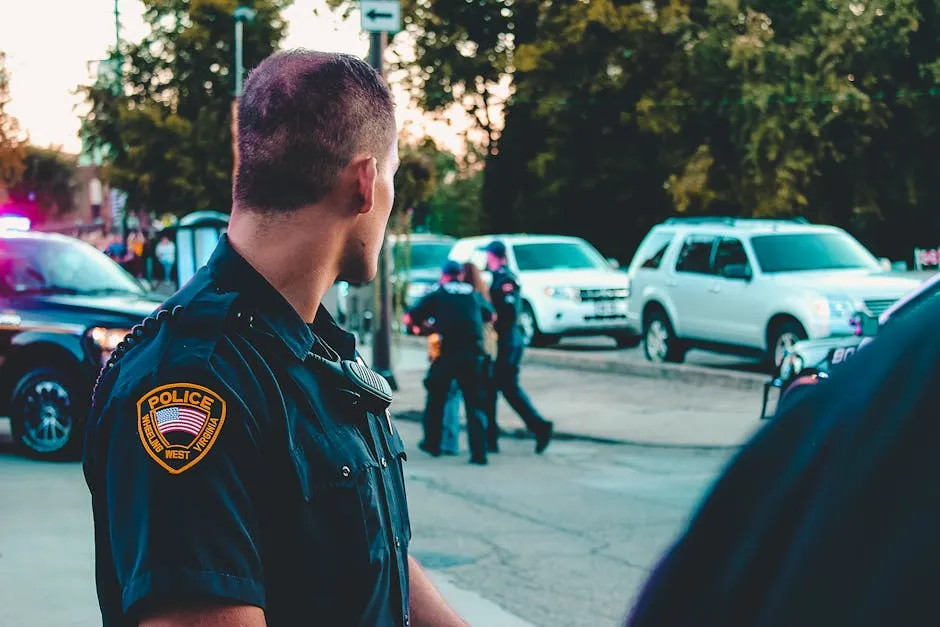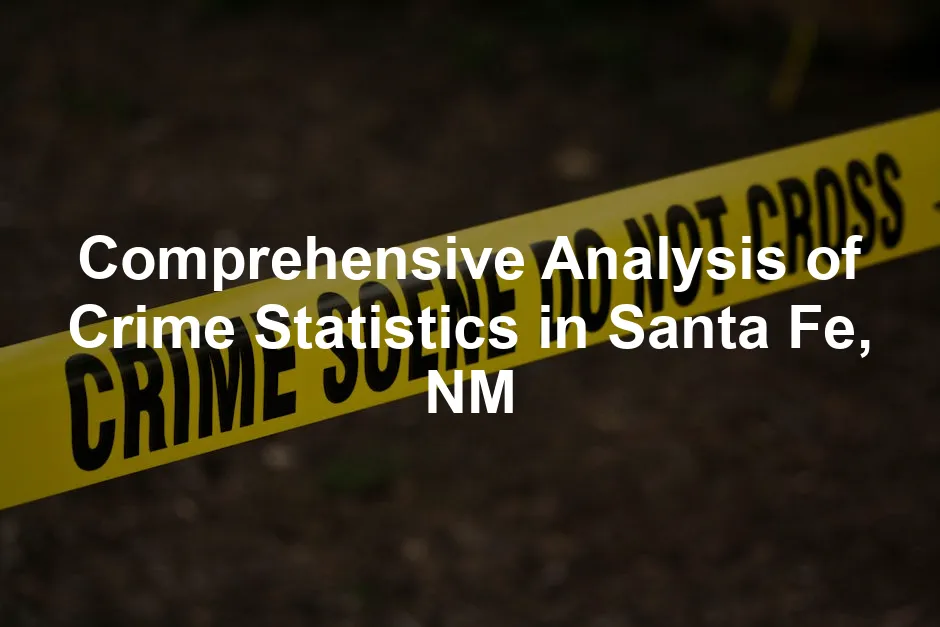Introduction
Crime statistics can sound about as exciting as watching paint dry, but stick with me! Understanding crime rates in Santa Fe, NM, is crucial for residents and visitors alike. Whether you’re a local or just passing through, knowing what’s happening can help keep you safe.
Santa Fe is famous for its stunning Pueblo-style architecture and vibrant arts scene. However, like any city, it grapples with crime. So, what’s the scoop on crime rates here?
In this article, we’ll take a closer look at crime rates in Santa Fe. We’ll compare them to national averages, discuss trends over time, and explore safety perceptions among residents. After all, knowledge is power!
Understanding these statistics can help you make informed decisions. Whether choosing a neighborhood to live in or figuring out how to enjoy your visit, these insights matter. So, buckle up and let’s get into it!
Overview of Santa Fe
Geographic and Demographic Context
Santa Fe, the capital of New Mexico, is a unique blend of history and culture. Nestled in the foothills of the Sangre de Cristo Mountains, it boasts breathtaking views and a rich heritage. With a population of approximately 101,181, it’s the fourth-largest city in New Mexico.
The city is known for its artistic community, with numerous galleries and festivals. From the famous Santa Fe Opera to the bustling Plaza, there’s something for everyone. However, this cultural richness is paired with complex social dynamics that can influence crime rates.
Santa Fe is a melting pot of cultures, including Native American, Hispanic, and Anglo influences. This diversity adds to the city’s charm, but it also creates a unique social environment where crime can flourish or diminish based on various factors.
To delve deeper into the psychological aspects of crime, consider exploring The Sociopath Next Door. This book explores the ruthless versus the rest of us and offers insight into the minds that may contribute to crime.
The Concept of Crime Statistics
Now, let’s break down what crime statistics are and how they work. Crime statistics provide a quantitative measure of crime in a specific area. They are typically reported annually and cover various offenses.
These statistics are divided into two main categories: violent crimes and property crimes. Violent crimes include offenses such as murder, rape, robbery, and assault. These are the serious crimes that often make headlines and can instill fear in communities.
Property crimes, on the other hand, involve the theft or destruction of someone’s property. This category includes burglary, larceny, motor vehicle theft, and vandalism. Understanding the difference between these categories helps in assessing safety within a community.
Analyzing crime statistics helps law enforcement and community leaders understand trends, allocate resources, and develop strategies to enhance public safety. So, next time you hear about crime rates, remember that it’s more than just numbers—it’s about people and communities.

Current Crime Statistics in Santa Fe
Violent Crime Statistics
Santa Fe has seen its share of violent crime, and the numbers are telling. As of the latest available data, the violent crime rate in Santa Fe stands at 819 incidents per 100,000 residents, which is notably higher than the national average of 781 per 100,000. Breaking it down further, here’s how the grim statistics stack up:
- Murder: 5 cases
- Rape: 42 occurrences
- Robbery: 100 incidents
- Assault: 672 reports
These figures come from reliable sources, including the FBI and local law enforcement reports, ensuring accuracy.
What does this mean for community safety? Well, it indicates a higher risk for residents compared to many other cities in the U.S. When one in 109 people has a chance of becoming a victim of violent crime, it’s a wake-up call! This reality often leads to heightened anxiety among residents and a push for more proactive community safety measures.
Furthermore, the statistics regarding assault highlight the importance of awareness and preventive strategies.
Understanding the statistics of assault can provide insights into the broader issues of community safety. campus sexual assault statistics
Property Crime Statistics
Now let’s turn our gaze to property crimes, which also tell a concerning story. The property crime rate in Santa Fe is 4,333 per 100,000 residents, a significant leap from the national average of 2,984 per 100,000. Here’s a closer look at the specific types of property crimes:
- Burglary: 955 incidents
- Theft: 2,713 occurrences
- Vehicle Theft: 665 reports
These figures illustrate the challenges Santa Fe faces, especially when you consider that one in 21 residents may become a victim of property crime. Comparatively, when looking at the national averages, Santa Fe’s property crime rates are alarming, signaling a pressing need for enhanced security measures and community vigilance.
To bolster your home security, consider investing in a Smart Home Security System. With its advanced technology, you can monitor your home from anywhere, providing peace of mind even when you’re away. It’s like having a security guard, but without the hefty salary!

Yearly Crime Trends
Examining the crime trends over the past decade reveals some striking patterns. Data shows that violent crime has increased by about 99% in Santa Fe, while property crime has skyrocketed by 188%. A graph or table representing these trends would illustrate this alarming growth effectively.
For instance, the number of assaults has surged, reflecting broader societal issues that necessitate immediate attention. Meanwhile, property crimes have also seen a troubling rise, with thefts becoming alarmingly frequent.
Understanding these trends is essential for both current residents and potential visitors. It highlights the importance of taking precautions and staying informed about the neighborhoods in Santa Fe.
In summary, the crime statistics in Santa Fe paint a picture that’s both complex and concerning. With higher-than-average rates for both violent and property crimes, residents are urged to remain vigilant. Community safety initiatives and increased awareness can play crucial roles in addressing these challenges. As Santa Fe continues to grow, so too must its commitment to ensuring that safety remains a top priority for all its inhabitants.
Comparison with National Averages and Nearby Cities
National Crime Averages
When comparing Santa Fe’s crime rates with national averages, the differences are striking. Santa Fe experiences a violent crime rate of 819 incidents per 100,000 residents. This is about 5% higher than the national average of 781 per 100,000. The property crime rate in Santa Fe is particularly alarming, standing at 4,333 per 100,000 residents, significantly higher than the national average of 2,984 per 100,000.
Why do these discrepancies matter? For residents and visitors, they indicate a heightened risk of becoming a victim of crime. With one in 109 people facing a chance of violent crime and one in 21 for property crime, the statistics present a sobering reality. These figures serve as a wake-up call, prompting discussions about community safety and the need for enhanced crime prevention strategies.

Crime Statistics in Nearby Cities
Looking beyond Santa Fe, let’s cast a glance at crime rates in nearby cities like Albuquerque, Espanola, and Edgewood.
In Albuquerque, the violent crime rate is 1,364.78 per 100,000, which is substantially higher than Santa Fe’s figure. This highlights a troubling trend, as both cities grapple with significant crime issues. In contrast, Edgewood touts a much lower violent crime rate of 324.6 per 100,000, making it a seemingly safer option for those seeking refuge from crime-ridden areas.
Espanola presents an even more concerning picture, with a staggering 2,934.5 violent crimes per 100,000 residents. This statistic places it among the most dangerous cities in New Mexico. It’s clear that each city has its own unique challenges, and crime rates can vary widely even within short distances.
The property crime rates tell a similar story. Santa Fe’s 4,333 per 100,000 far surpasses Edgewood’s 1,233.6 and Espanola’s 4,752.5. This comparison emphasizes the need for Santa Fe residents to remain vigilant and community-oriented.
In summary, understanding crime statistics in relation to nearby cities helps paint a comprehensive picture of safety in the region. While Santa Fe faces serious challenges, nearby cities exhibit varying crime trends that also warrant attention.

Socioeconomic Factors Influencing Crime
Economic Conditions
The relationship between socioeconomic factors and crime in Santa Fe is undeniable. A closer look at poverty rates, unemployment statistics, and education levels reveals how these elements intertwine with crime rates.
Santa Fe’s poverty rate sits at 14.3%, slightly lower than the national average of 15.1%. However, that slight difference does not diminish the impact of poverty on crime. Communities grappling with economic hardship often witness higher crime rates, as individuals may resort to illegal activities out of desperation.
Unemployment rates in Santa Fe are 2.9%, which is lower than the national average of 4.7%. While a lower unemployment rate typically correlates with reduced crime, the reality is more complex. The presence of underemployment or low-wage jobs can still contribute to higher crime rates, as individuals struggle to make ends meet.
Education levels also play a crucial role in crime statistics. Approximately 83.8% of residents have completed high school, aligning closely with the national rate of 83%. Higher education levels often correlate with lower crime rates, as individuals with more education tend to have better job prospects and income potential.
In conclusion, socioeconomic factors in Santa Fe present a multifaceted challenge. While the city boasts lower unemployment and comparable education rates, poverty remains a significant concern. Addressing these underlying issues is essential for reducing crime and enhancing community safety.

Crime Prevention Strategies and Resources
Community Initiatives
In Santa Fe, local initiatives are making strides in crime prevention and enhancing community safety. One notable program is the Santa Fe Community Policing Initiative. This program focuses on building trust between residents and law enforcement. Officers engage with community members, attend neighborhood meetings, and participate in local events. It’s like a block party, but with badges!
Another key initiative is the Neighborhood Watch Program. Residents band together to keep an eye on their streets. It’s a grassroots effort that empowers locals to take responsibility for their own safety. Studies show that neighborhoods with active watch groups tend to see lower crime rates. Who knew a little vigilance could go a long way?
Moreover, the city supports youth engagement programs. These initiatives provide at-risk kids with constructive activities. By keeping youth busy, they stay away from trouble. Programs like after-school sports and arts workshops are essential for community cohesion. When kids feel connected, they’re less likely to engage in criminal behavior.
Santa Fe also promotes educational workshops on crime prevention. These sessions cover everything from personal safety tips to home security measures. Knowledge is power, and these workshops equip residents to protect themselves and their properties.
Speaking of home security, you may want to consider a Home Security Guide. This resource provides valuable insights into protecting your home and family, ensuring that you’re well-equipped to handle any situation.

Law Enforcement Resources
Santa Fe is home to several law enforcement agencies dedicated to community safety. The Santa Fe Police Department is the primary agency enforcing laws and responding to emergencies. They operate various units, including the Crime Prevention Unit, which focuses on proactive measures to reduce crime.
Residents can access a plethora of resources via the department’s website. This includes the option to report crimes online, which is incredibly convenient. No more waiting for an officer to arrive while you sip your morning coffee!
Additionally, the police department runs regular community forums. These forums allow residents to voice concerns and ask questions directly to law enforcement officials. This transparency fosters trust and encourages community involvement. The more involved residents are, the safer everyone feels.
Moreover, the Santa Fe Crime Stoppers program encourages citizens to report criminal activity anonymously. This initiative offers rewards for information leading to arrests. It’s a win-win situation—help the community and potentially earn some cash on the side!
To further engage the community, the police department collaborates with local organizations. They host safety fairs, distribute crime prevention literature, and participate in outreach programs. With these combined efforts, Santa Fe is fostering a safer environment for all its residents.
In summary, crime prevention in Santa Fe hinges on collaboration between law enforcement and the community. Through initiatives like community policing, neighborhood watch groups, and educational workshops, residents are empowered to take action. The resources provided by law enforcement further enhance this collaboration, ensuring that safety remains a shared responsibility. Together, they are creating a more secure Santa Fe, one step at a time.

Conclusion
In summary, Santa Fe, NM, grapples with crime rates that exceed national averages. The violent crime rate stands at 819 incidents per 100,000 residents, while property crimes soar to 4,333 per 100,000. These figures paint a vivid picture of the safety landscape in this culturally rich city. Residents and visitors alike must remain vigilant and informed about the crime statistics.
Understanding these numbers is key. They serve as a reminder that crime can touch anyone, anywhere. Staying aware of the risks can help individuals make better choices, whether it’s picking neighborhoods or planning outings. The importance of being informed cannot be overstated.
Community engagement plays a crucial role in enhancing safety. By participating in local initiatives and supporting police efforts, residents can contribute to a more secure environment. Proactive measures, like neighborhood watch programs, have shown to be effective in reducing crime rates. When communities come together, they become more resilient against crime.
So, let’s keep the conversation going! Share insights and concerns with your neighbors. Attend community meetings and collaborate with law enforcement. Together, we can create a safer Santa Fe for everyone. Knowledge is a powerful tool, so let’s use it wisely!
FAQs
What are the most common types of crime in Santa Fe?
The most prevalent crimes in Santa Fe include property crimes such as theft, burglary, and vehicle theft. The city has also seen significant rates of violent crimes, particularly aggravated assaults and robberies. According to recent data, the breakdown is alarming, with thefts alone accounting for over 2,700 incidents.
How does Santa Fe’s crime rate compare to other cities in New Mexico?
When compared to other New Mexico cities, Santa Fe’s crime rates are notably high. For instance, Albuquerque has a higher violent crime rate at 1,364.78 per 100,000 residents, while Espanola shows an alarming 2,934.5. In contrast, Edgewood boasts a much lower rate of 324.6. Santa Fe’s property crime rate, however, surpasses many nearby cities.
What should I do if I become a victim of crime in Santa Fe?
If you fall victim to a crime, the first step is to report it to the Santa Fe Police Department. You can do this by calling their non-emergency number or visiting the station in person. Additionally, consider reaching out to local victim assistance programs, which can provide support and resources during this difficult time.
Are there any specific areas in Santa Fe that are safer than others?
Yes, perceptions of safety vary across neighborhoods in Santa Fe. Areas such as Eldorado and the historic district are generally viewed as safer. Conversely, neighborhoods near the plaza and certain industrial areas often receive mixed reviews regarding safety. Engaging with local community members can provide insights into which areas might be best to avoid, especially after dark.
How can residents help to reduce crime in their community?
Residents can take several proactive steps to help reduce crime. Joining or forming a neighborhood watch group is a great start. This fosters communication and vigilance among neighbors. Additionally, participating in community policing initiatives and attending local safety workshops can empower residents while building trust with law enforcement. Taking these small steps can lead to a significant impact on overall safety in Santa Fe.
Please let us know what you think about our content by leaving a comment down below!
Thank you for reading till here 🙂
All images from Pexels




